Depressing Iron Mineral by Metallic-Starch Complex (MSC) in Reverse Flotation and Its Mechanism
Abstract
:1. Introduction
2. Materials and Methods
2.1. Materials
2.2. Methods
2.2.1. Reverse Cationic Flotation Tests
2.2.2. Total Organic Carbon (TOC) Analyses for Adsorption
2.2.3. Adsorption Behaviour of the Metallic-Starch Complex (MSC) on Minerals
2.2.4. Zeta Potential Measurements
2.2.5. Fourier Transform Infrared Spectroscopic (FTIR) and X-ray Diffraction (XRD) Studies
3. Results and Discussion
3.1. Characterization of the Metallic-Starch Complex (MSC)
3.2. Reverse Cationic Flotation Tests
3.3. Adsorption Amount of Reagents onto Iron Minerals in Flotation
3.4. Adsorption Characteristics of the MSC onto Mica
3.5. Zeta Potential Measurements
3.6. FTIR Spectra of the Hematite Conditioned with the MSC (Fe3+-Starch)
4. Conclusions
Acknowledgments
Author Contributions
Conflicts of Interest
References
- Ma, X.; Marques, M.; Gontijo, C. Comparative studies of reverse cationic/anionic flotation of Vale iron ore. Int. J. Miner. Process. 2011, 100, 179–183. [Google Scholar] [CrossRef]
- Filippov, L.O.; Filippova, I.V.; Severov, V.V. The use of collectors mixture in the reverse cationic flotation of magnetite ore: The role of Fe-bearing silicates. Miner. Eng. 2010, 23, 91–98. [Google Scholar] [CrossRef]
- Turrer, H.D.G.; Peres, A.E.C. Investigation on alternative depressants for iron ore flotation. Miner. Eng. 2010, 23, 1066–1069. [Google Scholar] [CrossRef]
- Xia, L.; Zhong, H.; Liu, G.; Wang, S. Utilization of soluble starch as a depressant for the reverse flotation of diaspore from kaolinite. Miner. Eng. 2009, 22, 560–565. [Google Scholar] [CrossRef]
- Weissborn, P.K.; Warren, L.J.; Dunn, J.G. Selective flocculation of ultrafine iron ore. Mechanism of adsorption of starch onto hematite. Colloids Surf. A 1995, 99, 11–27. [Google Scholar] [CrossRef]
- Kar, B.; Sahoo, H.; Rath, S.S.; Das, B. Investigations on different starches as depressants for iron ore flotation. Miner. Eng. 2013, 49, 1–6. [Google Scholar] [CrossRef]
- Tharanathan, R.N. Starch—Value addition by modification; Food Hydrocoll. Crit. Rev. Food Sci. Nutr. 2005, 45, 371–384. [Google Scholar] [CrossRef] [PubMed]
- Liu, Q.; Wannas, D.; Peng, Y. Exploiting the dual functions of polymer depressants in fine particle flotation. Int. J. Miner. Process. 2006, 80, 244–254. [Google Scholar] [CrossRef]
- Filippov, L.O.; Severov, V.V.; Filippova, I.V. An overview of the beneficiation of iron ores via reverse cationic flotation. Int. J. Miner. Process. 2014, 127, 62–69. [Google Scholar] [CrossRef]
- Tang, M.; Liu, Q. The acidity of caustic digested starch and its role in starch adsorption on mineral surfaces. Int. J. Miner. Process. 2012, 112, 94–100. [Google Scholar] [CrossRef]
- Tang, M.; Wen, S.; Liu, D. Effects of Heating-or Caustic-Digested Starch on its Flocculation on Hematite. Miner. Process. Extr. Metall. Rev. 2016, 37, 49–57. [Google Scholar] [CrossRef]
- Peres, A.E.C.; Correa, M.I. Depression of iron oxides with corn starches. Miner. Eng. 1996, 9, 1227–1234. [Google Scholar] [CrossRef]
- Weissenborn, P.K. Behaviour of amylopectin and amylose components of starch in the selective flocculation of ultrafine iron ore. Int. J. Miner. Process. 1996, 47, 197–211. [Google Scholar] [CrossRef]
- Niemelä, K. Conversion of xylan, starch, and chitin into carboxylic acids by treatment with alkali. Carbohydr. Res. 1990, 204, 37–49. [Google Scholar] [CrossRef]
- Jebber, K.A.; Zhang, K.; Cassady, C.J.; Chung-Phillips, A. Ab initio and experimental studies on the protonation of glucose in the gas phase. J. Am. Chem. Soc. 1996, 118, 10515–10524. [Google Scholar] [CrossRef]
- Yue, T.; Wu, X.Q. Magnetic seeding depression in flotation of hematite ore slimes. Physicochem. Probl. Miner. Process. 2018, in press. [Google Scholar]
- Wu, X.Q.; Yue, T.; Wang, Z.X. Preparation Method and Application of Metallic-Starch Compound Depressants: China. Patent No. 201710049853.8, 23 January 2017. [Google Scholar]
- Wu, X.Q.; Wang, Z.X.; Yue, T. Study on depressing effect and mechanism of ferric-starch complex in reverse flotation of an iron mine. Met. Mine 2017, 497, 70–74. (In Chinese) [Google Scholar]
- Zhang, M.; Zhang, P.C.; Ni, S.J.; Huang, Y. Experimental study of hydrothermal synthesis of β-FeOOH and removal of Cr (VI). J. Miner. Petrol. 2016, 36, 115–120. (In Chinese) [Google Scholar]
- Xu, Y.Q.; Yang, M.; He, C.D.; Xiong, H.X. Characterization and spectral analysis of the stable mineral phases α,β-FeOOH included in iron oxyhydroxides. Spectrosc. Spect. Anal. 2013, 33, 3330–3333. (In Chinese) [Google Scholar]
- Chen, S.Z.; Zhong, S.H. Studies on the photo stimulated surface-catalytic reaction of carbon dioxide and water over Cu/ZnO-NiO. Chem. J. Chin. Univ. 2003, 24, 135–139. (In Chinese) [Google Scholar]
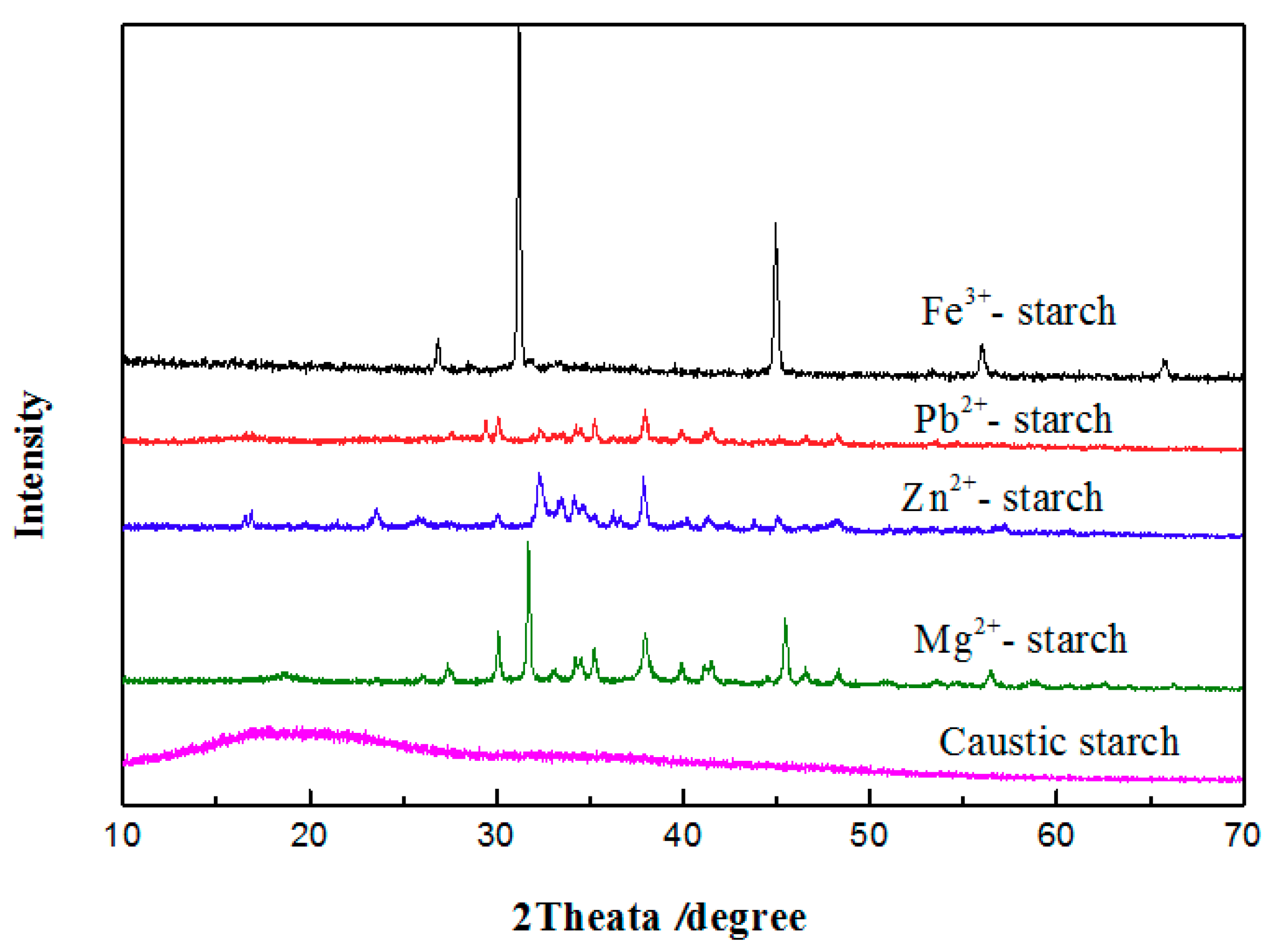
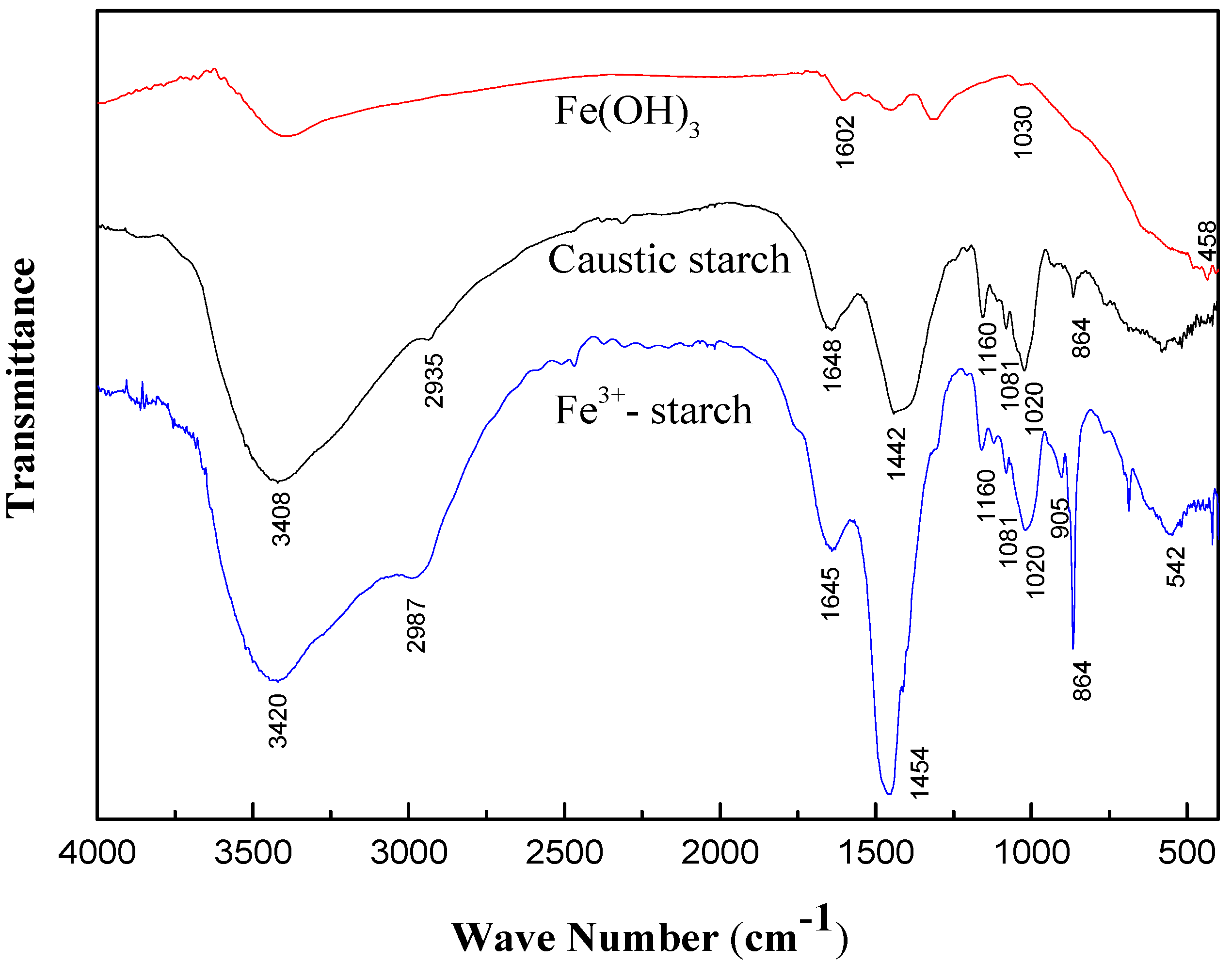
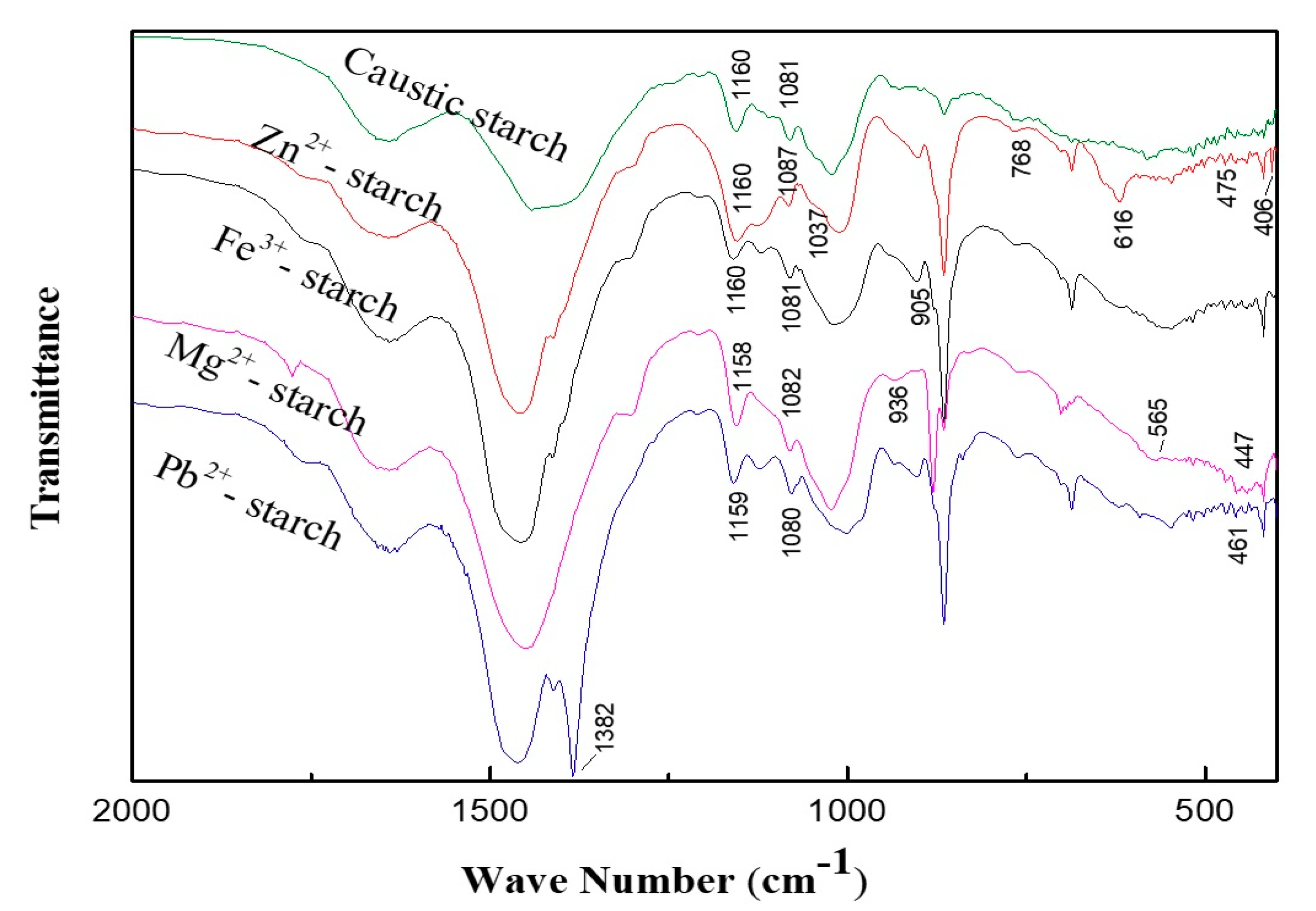
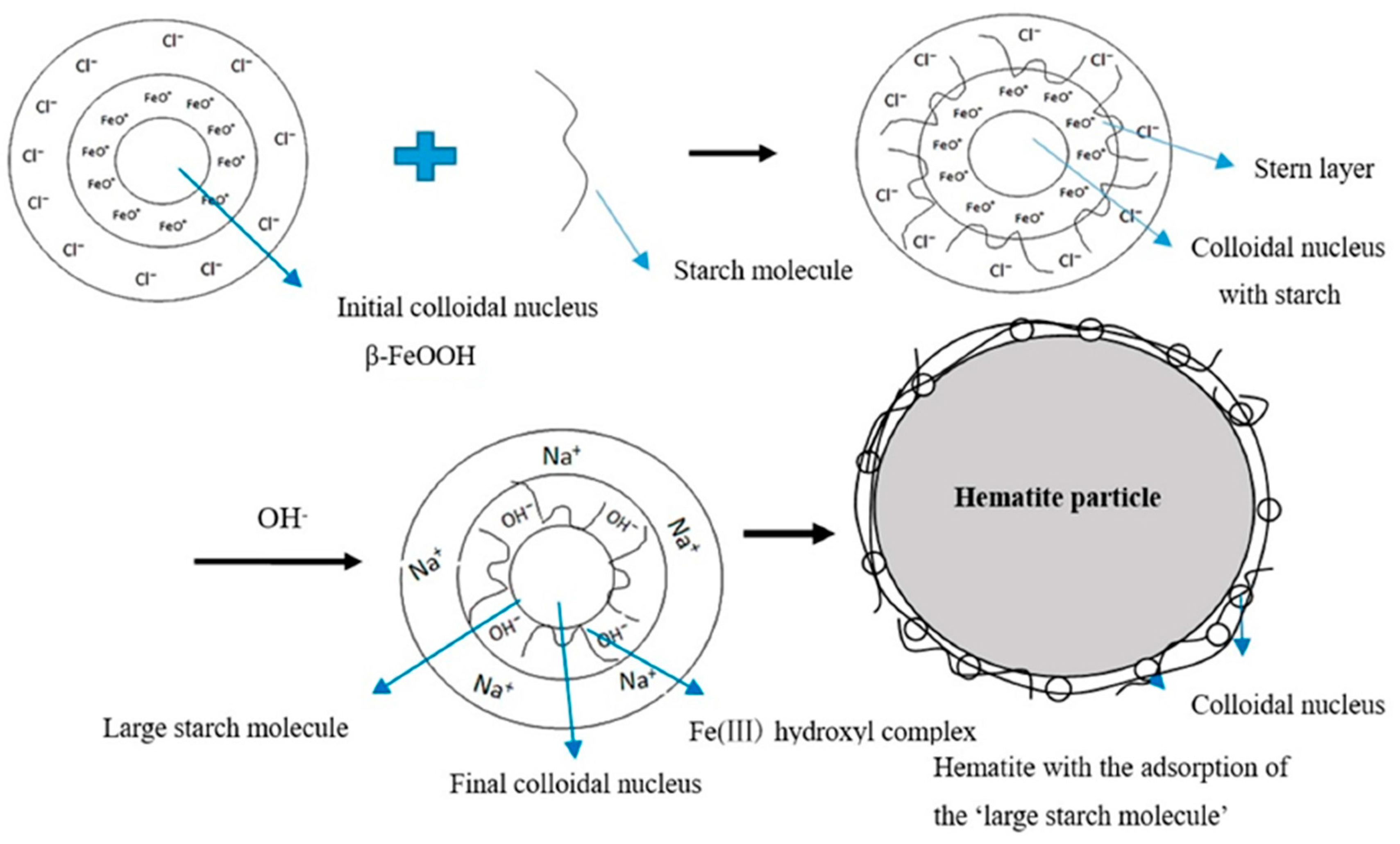

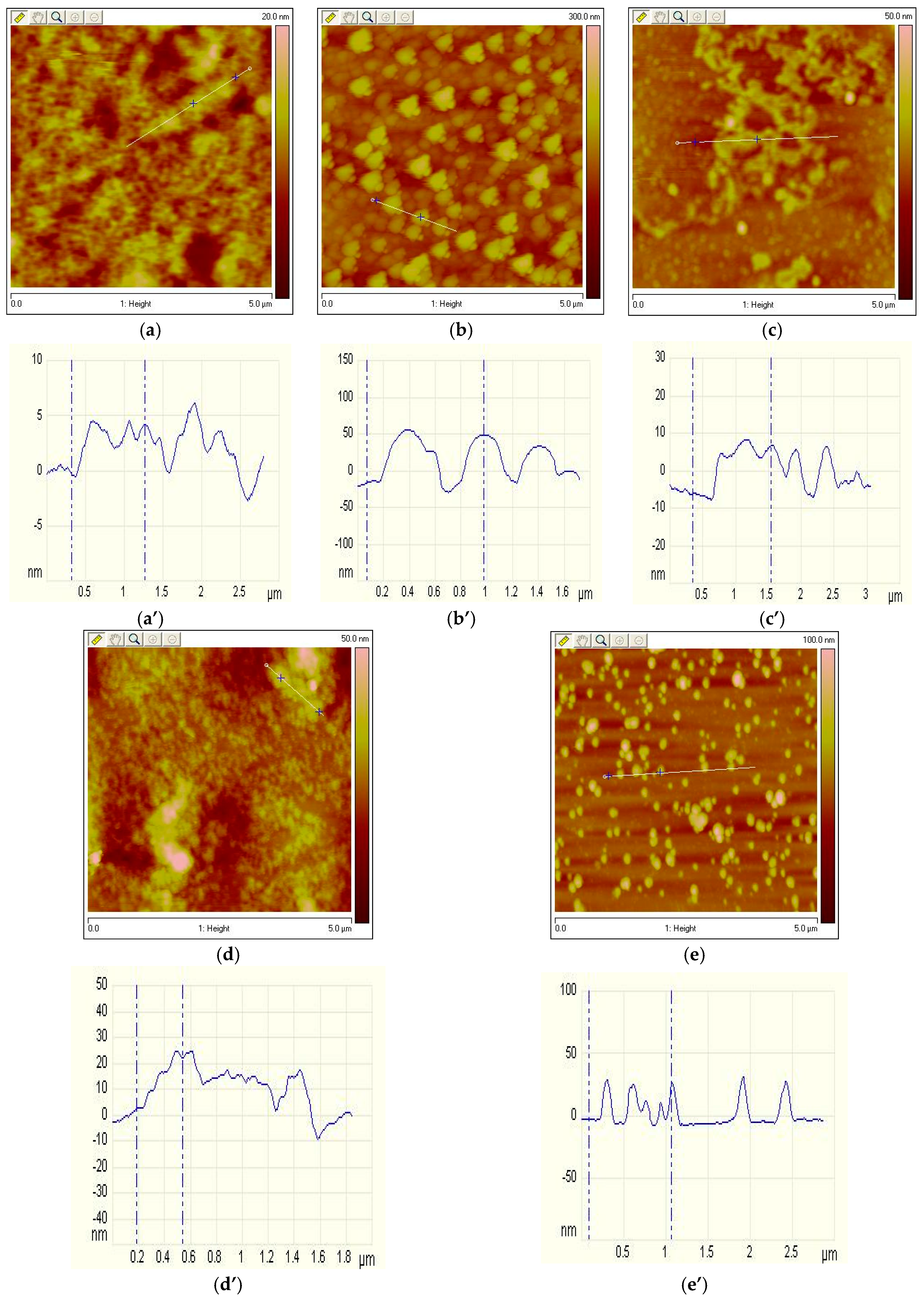
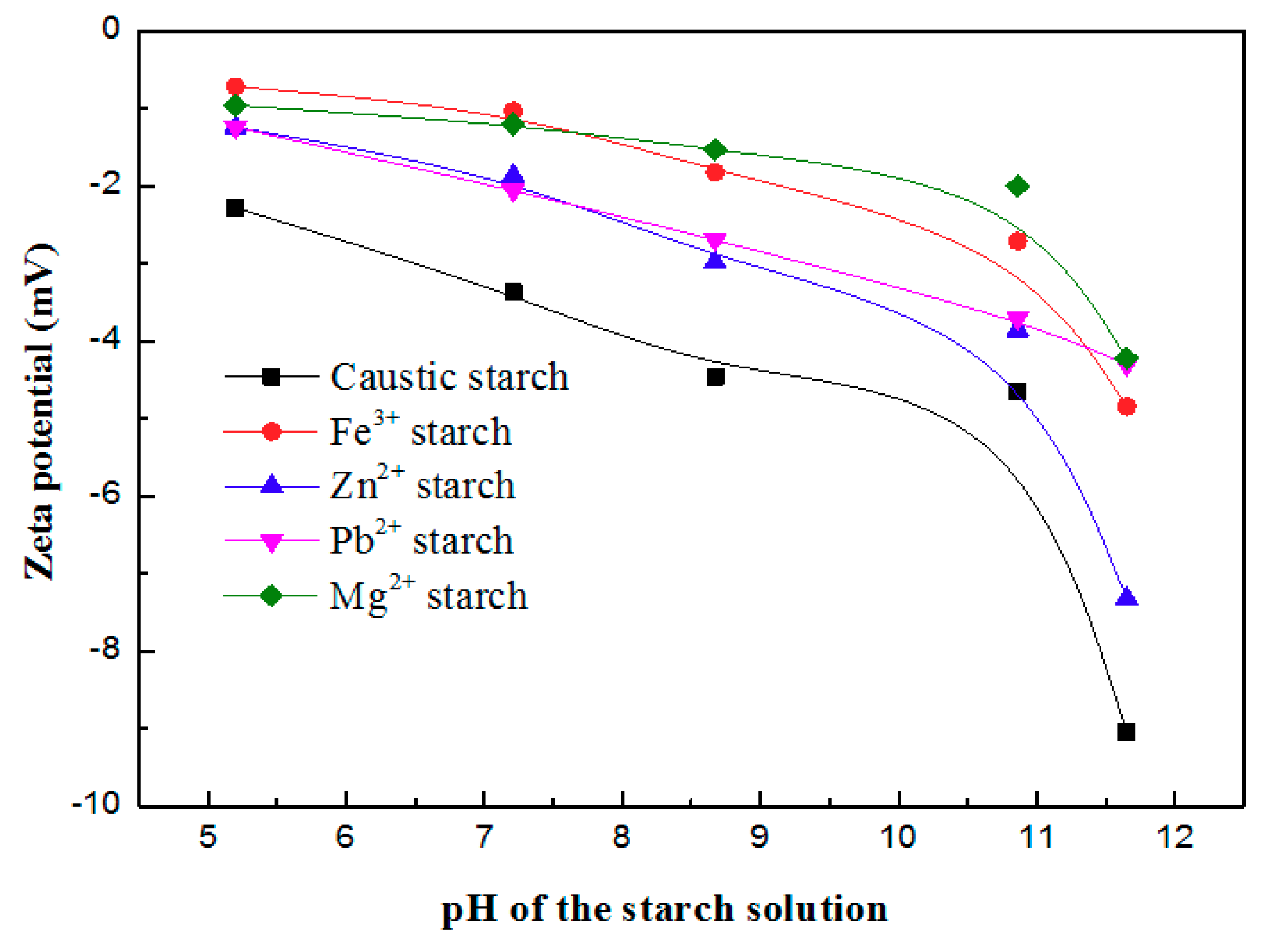
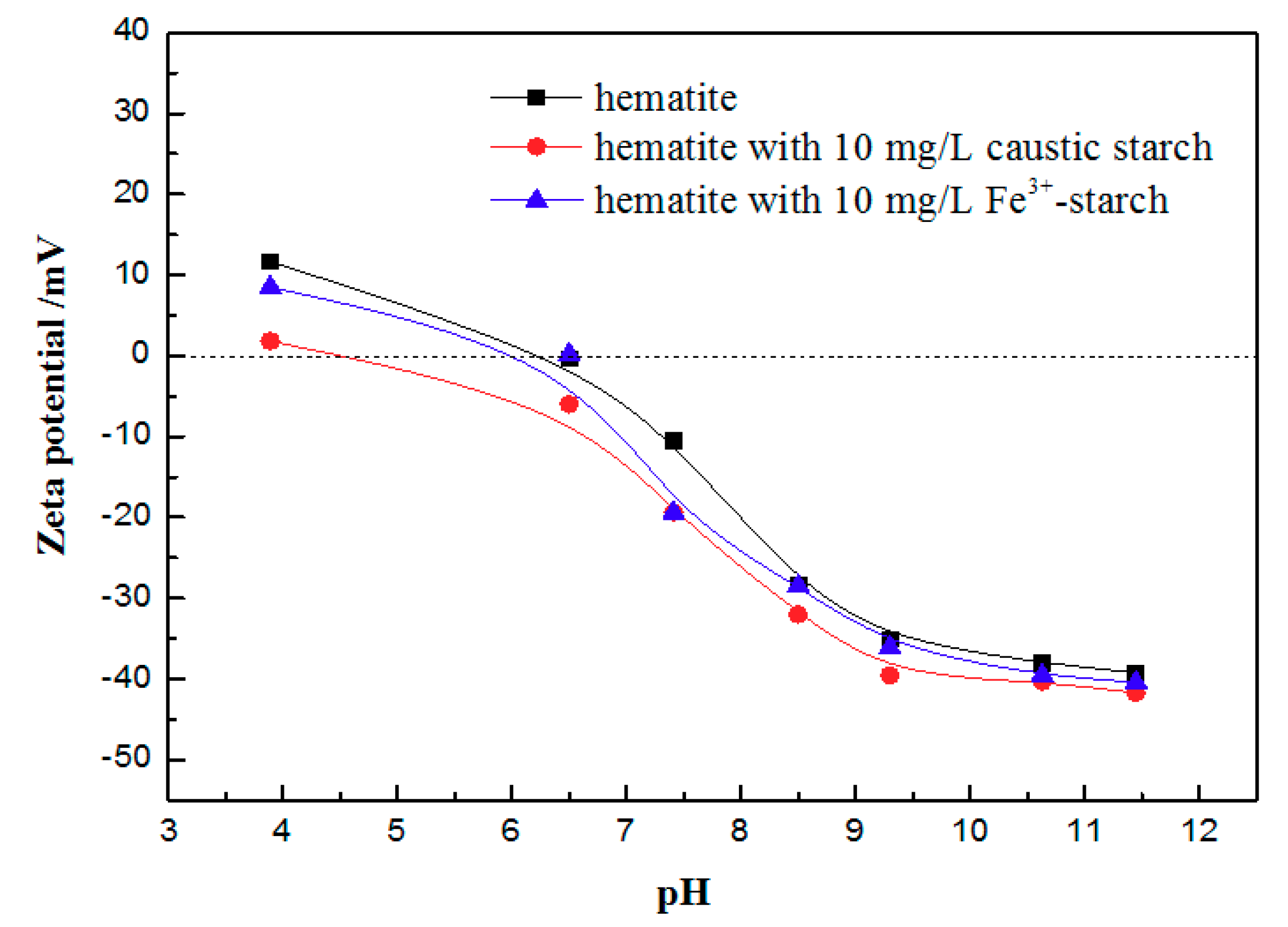
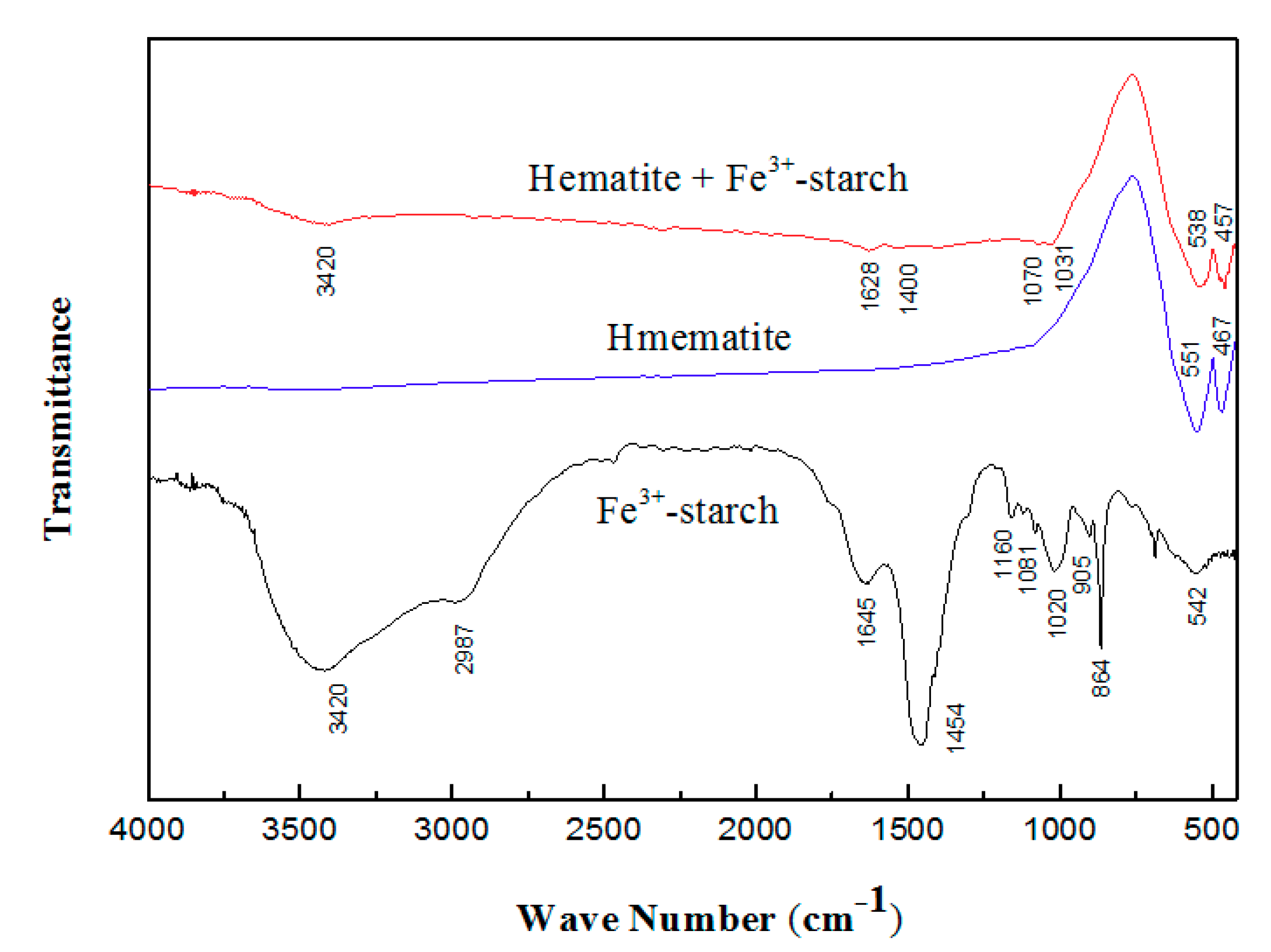
| MSC | Caustic Starch | Fe3+-Starch | Zn2+-Starch | Pb2+-Starch | Mg2+-Starch |
|---|---|---|---|---|---|
| Turbidity/NTU | 28.32 | 144.21 | 230.63 | 187.41 | 346.83 |
| Average size/nm | 97.47 | 202.22 | 464.34 | 326.70 | 645.18 |
| Depressant | Mass Recovery/% | Grade Total Fe/% | Recovery of Total Fe/% |
|---|---|---|---|
| Caustic starch | 72.55 | 58.11 | 81.79 |
| Fe3+-starch | 76.65 | 58.18 | 86.50 |
| Zn2+-starch | 80.16 | 57.49 | 89.40 |
| Pb2+-starch | 78.70 | 57.74 | 88.15 |
| Mg2+-starch | 76.02 | 57.96 | 85.47 |
| Depressant | Recovery of TFe/% | Adsorption of Starch/mg/g | Adsorption of DDA/mg/g |
|---|---|---|---|
| Caustic starch | 81.79 | 0.2105 | 0.2317 |
| Fe3+-starch | 86.50 | 0.2496 | 0.2187 |
| Zn2+-starch | 89.40 | 0.3103 | 0.2206 |
| Pb2+-starch | 88.15 | 0.2788 | 0.2216 |
| Mg2+-starch | 85.47 | 0.2598 | 0.2253 |
© 2018 by the authors. Licensee MDPI, Basel, Switzerland. This article is an open access article distributed under the terms and conditions of the Creative Commons Attribution (CC BY) license (http://creativecommons.org/licenses/by/4.0/).
Share and Cite
Yue, T.; Wu, X. Depressing Iron Mineral by Metallic-Starch Complex (MSC) in Reverse Flotation and Its Mechanism. Minerals 2018, 8, 85. https://doi.org/10.3390/min8030085
Yue T, Wu X. Depressing Iron Mineral by Metallic-Starch Complex (MSC) in Reverse Flotation and Its Mechanism. Minerals. 2018; 8(3):85. https://doi.org/10.3390/min8030085
Chicago/Turabian StyleYue, Tao, and Xiqing Wu. 2018. "Depressing Iron Mineral by Metallic-Starch Complex (MSC) in Reverse Flotation and Its Mechanism" Minerals 8, no. 3: 85. https://doi.org/10.3390/min8030085
APA StyleYue, T., & Wu, X. (2018). Depressing Iron Mineral by Metallic-Starch Complex (MSC) in Reverse Flotation and Its Mechanism. Minerals, 8(3), 85. https://doi.org/10.3390/min8030085




